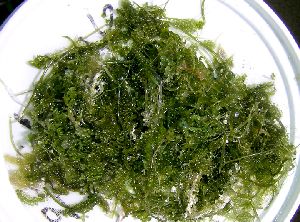|
FAQs about Seahares,
Suborder Anaspidea,
Foods/Feeding/Nutrition
Related Articles: Sea Slugs, Nudibranchs,
Related FAQs: Seahares
1, Seahare Identification,
Seahare Behavior, Seahare Compatibility, Seahare Stocking/Selection, Seahare Systems, Seahare Disease, Seahare Reproduction, & FAQs
on: Seaslugs 1, Seaslugs 2, Seaslug Identification, Seaslug Behavior, Seaslug Compatibility, Seaslug Selection, Seaslug Systems, Seaslug Feeding, Seaslug Disease, Seaslug Reproduction, & Marine Snails 1, Marine Snails 2, Marine Snails 3, Nudibranchs, Nudibranchs 2, Nudibranch Identification, Nudibranch Behavior, Nudibranch Compatibility, Nudibranch Selection, Nudibranch Systems, Nudibranch Feeding, Nudibranch Disease, Nudibranch Reproduction, Berghia Nudibranchs, Snail ID 1, Snail
ID 2, Snail ID
3,
|

|
Aplysia feeding 11/6/07 Hello everyone, A friend of
mine purchased a sea hare as an algae-eater, on the recommendation of
her local marine aquarium store. The slug devoured the problem hair
algae within days. The owner of the store says that she'll probably
have to bring the sea slug back because there isn't any food left;
it seems he sort of loans them out as biological control rather than
sells them as pets! Anyway, my question: will Aplysia eat anything
other than live green algae? I suggested Plec wafers and Sushi Nori,
but is there anything better? Or is the store owner right, that these
sea slugs shouldn't be kept in tanks once the green algae is gone?
<Well, I consulted with my friend Mike G. (gastropod enthusiast) and
he informed me that the Univ. of Miami raises them on Gracilaria sp.
algae. However, please note that these animals don't live very long
even if you do feed them right. Even in the wild, they only live maybe
2 years. And when they come into the aquarium hobby, they're likely
already at least 6 months old (maybe older). So please don't be too
crushed if it doesn't last long even if you find some Gracilaria to
feed it.> Thanks,
<De nada,
Sara M.>
| Death to Caulerpa! Hey all, Everyone here
has seen my tank. It's a pretty nice tank, and I am proud of
most of it. Well, perhaps I should rephrase that. I am proud of
everything except my Caulerpa. Grape and Parasail dominate my tank.
The grape hitch-hiked on my Ritteri's foot, the Parasail
literally grew out of the rocks. I saw it as benign, and left it.
Huge mistake. For several months now, I have not seen my rocks. The
Grape really does not grow too much, but the parasail does. It
covers the rockworks, and has smaller stems and tough roots, making
it impossible to extricate. <I lived through this same
problem quite a while ago. Aggressive manual removal which included
hand picking and a stiff bristled scrub brush along with dropping
the temp allowed grazers to get ahead of it. Eric
Borneman wrote a phenomenal piece on the specific nutrient ratios
that favor certain "algae", Cyanobacteria,
Dinoflagellates, etc. It is hard to find (I recently looked and
came up empty). If you can find it, it has some very useful
information that could be used to develop a strategy based on
manipulating an easily controlled nutrient (Nitrate
perhaps).> It grows over my corals, imbeds its roots in
their flesh, and starves them of light. It grows around 4 to 5
inches a day, and will not go away. Daily I pull out about this
much: |
|

|
| I have just recently acquired a 6" Sea Hare
from IslandReefs.com. The
owner there, Tom, says he feeds them Caulerpa as they have run out
of hair algae. Sadly, I have yet to see mine even notice the stuff!
He just glides right over it without a second glance...eats my Ulva
sp. Seaweed, my Nori, my Seaweed Selects, and my Hair Algae, but
not my Caulerpa. Tom swears they do, but I have yet to verify that.
<I have also heard the claim that these guys will eat Caulerpa,
but I would try and find out which kind they actually did eat. With
such a noxious battery of defensive chemicals, it is very likely
that some might be more or less palatable. Also, it is likely that
Caulerpa will only be consumed as a last resort. If other foods are
offered or available, they would be eaten first. So, you may have
to starve the See Hare into eating it.> What other means are
there of naturally controlling Caulerpa? I do know that a
specialized species of Sacoglossan Slug, Oxynoe viridis consumes
Caulerpa and Caulerpa only. I also know that no online vendor or
local vendor sells them. Help! I HATE MY CAULERPA! Mike Giangrasso
<You could take your cue from the loonies about San Diego bay
and in Australia and put a big tarp over it... Oh, No! Even
better.... blast it with bleach. Wait! Huge doses of Copper Sulfate
delivered with a fire hose! OK, all of those ideas would kill
everything in your tank, just like they killed everything in the
immediate area they were applied in the wild. And for our next
stupid human trick, we'll rid Hawaii of chameleons by
exfoliating the whole place with Agent Orange (the herbicide, not
the 80's Orange County surf-punk band). Sorry for the sarcastic
rant. As for the O. viridis, try IPSF, Inland Aquatics and do a
search on RC. Those are your best bets. Hope this helps.
AdamC.> |
Seahare comp., fdg. Hi Bob Another new question for
you......Does a Sea Hare care what it has in its mouth? <Mmmm>
That may sound really stupid but I have a Zoanthus colony with a very
fine hair algae (green, massively invasive) encroaching and I believe
smothering. If the Sea Hare chooses to eat the algae, will it also eat
the polyps in the same mouthful? <I do think Aplysiids care... and
Zoanthids are very toxic... Do read here:
http://wetwebmedia.com/seaslugsopisthobranchs.htm and the linked files
above... many Seahares are misplaced in aquariums... and elsewhere on
WWM re Zoanthid comp.> Best wishes as always Sarah
<RMF>
|
|

